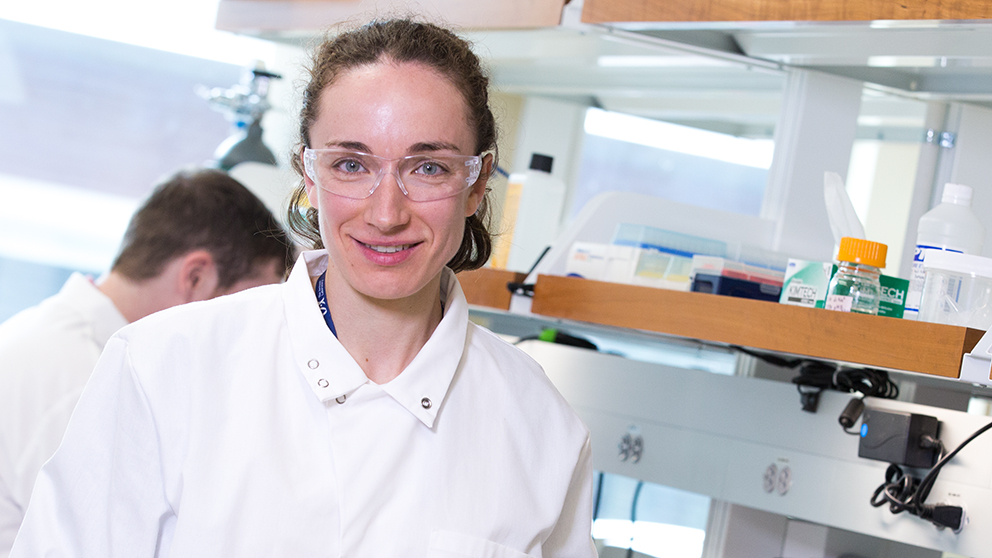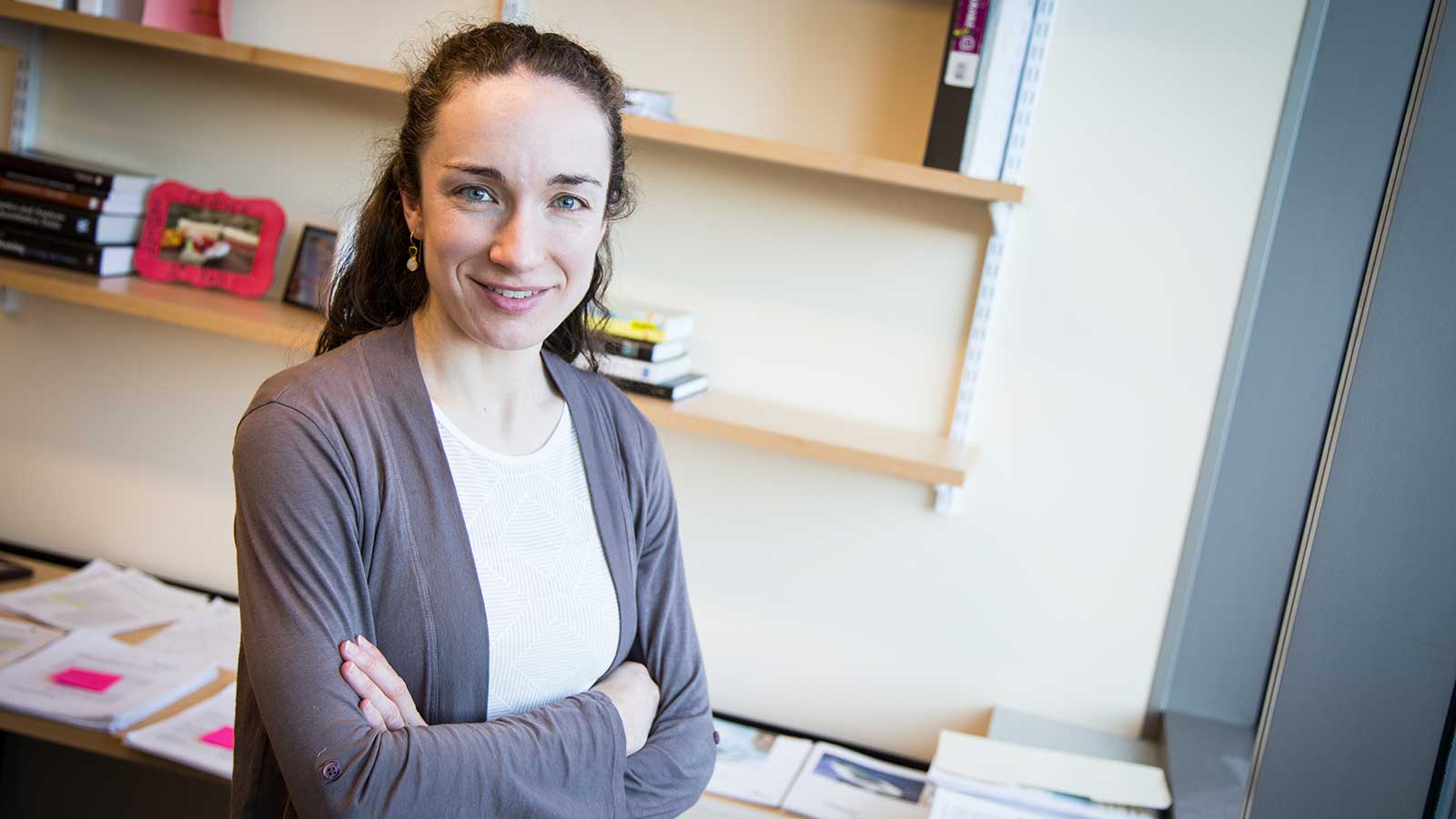
Jackson Laboratory Assistant Professor Beth Dumont is researching the mechanisms that generate genetic diversity through the lens of evolution. JAX photo by Tiffany Laufer.
JAX Assistant Professor Beth Dumont, Ph.D., is working to better understand the processes that give rise to genetic diversity, and how specific variations can contribute to disease susceptibility.
The earliest genetics lesson that Beth Dumont, Ph.D.Researching the mechanisms that generate genetic diversity through the lens of evolutionAssistant Professor Beth Dumont, Ph.D., can remember introduced her to Gregor Mendel and his pea plants. Through selective breeding and crossbreeding of generations of his plants, Mendel discovered that certain simple traits — such as seed shape and flower color — are passed from parent to offspring in predictable patterns. Mendelian Rules of Inheritance further explain that every child receives one set of chromosomes from each of their parents, making up a new genome.
But for Dumont, the exceptions to Mendel’s model are far more interesting than the rules.
“We know that chromosomes don’t just get transmitted fully intact from one generation to the next — they’re subject to mutations, they undergo the process of recombination, and these are processes that are vital for driving evolution as well,” Dumont explains. “They’re the processes that generate all the genetic diversity that we see in the natural world, both on short timescales and on longer timescales.”
A mutation occurs when a genetic sequence is altered or changed through additions, deletions or substitutions. Recombination, on the other hand, is the rearrangement of pre-existing genetic material. Dumont has dedicated her career to better understanding these two molecular processes, which geneticists consider ‘the engines of genetic diversity.’
Interest in diversity
Dumont grew up in rural Maine, where she learned to appreciate natural diversity at a young age. She spent her days outside, no matter the weather, turning over rocks and inspecting pine cones. The inexhaustible shapes, sizes and patterns that she observed in her backyard inspired curiosity for the natural world that has only grown throughout her academic and professional career.
After her first year at Cornell, Dumont attended the Jackson Laboratory (JAX) Summer Student ProgramA ten-week summer research fellowship in mammalian genetics and genomics. Summer Student Program , where she was mentored by Dr. Malcolm Lyons in the laboratory of Dr. Beverly Paigen. Dumont’s exposure to science had been limited before that summer. Looking back, she credits her time in the summer student program as “life-changing.”
“At the end of the summer, what seized me the most was this recognition that the approach we were using to map genes contributing to phenotypic differences between strains [of mice] rested on the fact that they were genetically distinct from one another,” recalls Dumont. “That really got me interested in understanding where genetic diversity came from in the first place.”
When she returned to Cornell in the fall, Dumont reached out to several evolutionary biologists on campus. Dr. Andrew Clark — a well-known and respected population geneticist in the process of establishing a new lab at Cornell — offered Dumont a spot on his team.
“From the get-go, Beth had a knack for laboratory work,” Clark remembers. “She is careful, attentive, scrupulously honest and always thinking several steps ahead.”

Dumont graduated Summa Cum Laude and Phi Beta Kappa with a dual degree in Biology and Anthropology. She went on to complete her Ph.D. work at the University of Wisconsin Laboratory of Genetics. Her dissertation identified several loci that contribute to species differences in the recombination rate. Loci are specific, unchanging regions of a chromosome, much like a street address on a map. By identifying these loci, Dumont came one step closer to elucidating the cause of vastly divergent recombination rates between species.
“Beth excels at finishing projects, even when the results are complicated,” reports Dumont’s Ph.D. mentor, Bret Payseur. “Having Beth as my first graduate student was like winning the lottery on the first try.”
Hoping to expand upon her Ph.D. minor in biostatistics following her doctoral work, Dumont took a Senior Research Fellow position in the Laboratory of Dr. Evan Eichler at the University of Washington Department of Genome Sciences, followed by a Distinguished Postdoctoral Research Fellow position at the North Carolina State University Department of Biological Sciences.
During Dumont’s Ph.D. years, genome sequencing technologies became faster and cheaper, leading to their increased use in genetics laboratories across the United States.
“I realized if I was ever going to be competitive in harnessing those emergent technologies, I really needed to expand my computational skill set,” says Dumont. This realization motivated her to take positions in labs known for their massive data sets and their focus on computational genomics.
“It’s not sufficient to just generate data,” Dumont continues. “You need to know how to handle it and draw inferences from it, too.”
JAX homecoming
In 2016, 14 years after first setting foot at JAX, Dumont joined the faculty as an assistant professor. She now leads the Dumont lab and mentors summer students of her own.
“So much of what motivates the questions I ask and my day-to-day existence is just this innate curiosity about how inheritance works and basic questions about evolutionary mechanisms and mechanisms of mutation and recombination,” says Dumont.
Her lab at JAX takes this curiosity-driven approach and uses it to guide research questions about how exactly genetic diversity is generated. Why do recombination and mutation rates vary between species and individuals? What causes this variation? To what degree is this propensity for diversity encoded in our DNA?
Using the wild-derived inbred strains of mice at JAX, Dumont’s lab is finding that the tendency to engage in diversity-generating processes may actually be embedded in an individual’s genetic code. This means that while mutation and recombination account for all new variation within populations, these very same variations can encode for the frequency of mutation and recombination.
By understanding these complex interactions, geneticists can begin to unravel how genetic variants cause disease.
“Every disease has to start with a mutation somewhere,” explains Dumont. “And I’m really interested in understanding how those mutations pop up, why they pop up in specific places in the genome, and why they pop up at different rates in different individuals.”
Implications in disease research
Genetic diversity accounts not only for the visible differences between us — eye color, height, freckles, widow’s peak — but also for our varying risk of developing cancer, diabetes and other diseases.
“If we’re going to understand how specific genetic variant contributes to disease, it helps to have an understanding of where a particular genetic variant came from in the first place. That’s where my work comes in,” says Dumont.
Dumont’s research focuses on mutation and recombination in the germline (the testes and ovaries), which could tie into infertility research and treatment down the road. Further, the work being done on mutations in the Dumont lab may have implications for cancer research moving forward. By better understanding mutations and how they arise, scientists and doctors can better understand who is at risk for the mutations in somatic tissue that lead to cancer.
Reflecting on the future for her lab and her research, Dumont comments, “I couldn’t do this work anywhere other than JAX.”